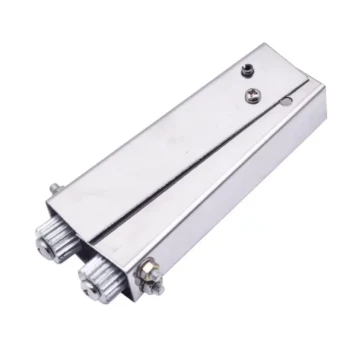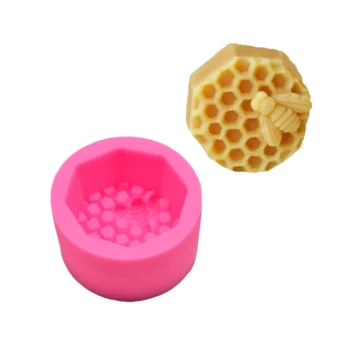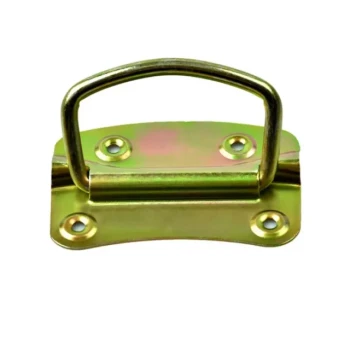For beekeepers seeking an effective Varroa mite treatment, oxalic acid presents a compelling option due to its unique combination of benefits. It is a naturally occurring organic acid that is highly effective against mites, relatively simple to apply, and critically, does not accumulate in the hive's wax comb, protecting the long-term health of your colony and its products.
Oxalic acid's primary advantage lies in its targeted effectiveness. It is a powerful tool for eliminating mites on adult bees (phoretic mites) without contaminating the wax, but its efficacy is entirely dependent on applying it when the colony has little to no sealed brood.
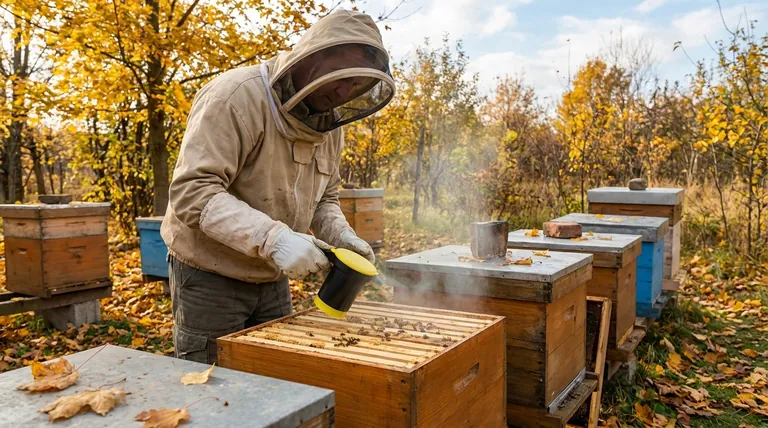
The Core Benefits of Oxalic Acid
Oxalic acid has become a foundational treatment in many Integrated Pest Management (IPM) plans for a few key reasons. Understanding these benefits helps you decide where it fits into your beekeeping calendar.
It Is an Organic and Natural Compound
Oxalic acid is not a synthetic, man-made chemical. It is an organic compound found naturally in many plants, including common vegetables like spinach, rhubarb, and beet leaves.
Using an organic-approved treatment is a significant advantage for beekeepers who aim to manage their hives with minimal chemical inputs.
It Protects Your Wax Comb
Perhaps the most significant technical advantage of oxalic acid is that it is not fat-soluble. This means it does not dissolve into or accumulate in the beeswax of the comb.
Many synthetic miticides are fat-soluble (lipophilic) and can build up in the wax over successive treatments. This residue can negatively impact bee health and potentially contaminate honey. Oxalic acid avoids this problem entirely, ensuring your comb remains clean.
It Offers High Efficacy on Phoretic Mites
Oxalic acid is extremely effective, often killing over 90% of the mites it comes into contact with. However, it only kills phoretic mites—those physically attached to the bodies of adult bees.
It does not penetrate the wax cappings of brood cells, so it cannot kill mites reproducing within the brood. This single fact is the most important factor in determining how and when to use it.
Common Application Methods
There are two primary, legally approved methods for applying oxalic acid. The choice often comes down to beekeeper preference, equipment, and the number of hives being treated.
The Dribble Method
This method involves mixing oxalic acid dihydrate crystals with warm 1:1 sugar syrup. The resulting solution is then measured and carefully "dribbled" directly onto the bees between the frames in the hive brood box.
The bees consume and share the syrup, spreading the acid throughout the cluster. It is a low-cost and straightforward application method.
The Vaporization Method
Also known as sublimation, this method uses a specialized tool to heat oxalic acid crystals. The heat turns the solid crystals directly into a vapor that fills the hive.
As the vapor cools, it re-crystallizes into microscopic, spiky crystals that coat the bees and hive surfaces. These sharp crystals are lethal to the soft-bodied Varroa mites upon contact.
Understanding the Trade-offs: Timing is Everything
The effectiveness of oxalic acid is not guaranteed; it is entirely conditional on proper timing. Using it at the wrong time of year will result in poor mite control and a wasted effort.
The "Broodless" Window is Critical
Because oxalic acid cannot penetrate capped brood, applying it when a colony has a large, established brood nest is highly ineffective. At any given time, 50-80% of the hive's Varroa mite population can be protected inside these sealed cells.
To achieve a successful treatment, you must apply oxalic acid when the colony is either naturally broodless or has the absolute minimum amount of brood possible.
Why Late Fall is a Strategic Choice
The most common time for an oxalic acid treatment is in the late fall or early winter, after the queen has stopped laying for the season. This natural brood break ensures that nearly all mites in the hive are in the phoretic stage and exposed to the treatment.
Applying it at this time dramatically reduces the mite load on the winter bee cluster, giving the colony a clean start and a much better chance of surviving until spring.
Making the Right Choice for Your Goal
Use these scenarios to determine if oxalic acid is the right treatment for your immediate objective.
- If your primary focus is preparing a colony for winter: Apply a single oxalic acid treatment once the colony is confirmed to be broodless in late autumn.
- If your primary focus is treating a new package or swarm: Use oxalic acid within the first week of hiving, before the queen has established a significant sealed brood pattern.
- If your primary focus is year-round mite management: Integrate oxalic acid as your dedicated "brood-break" treatment, but rely on other mite control methods during the spring and summer when brood is plentiful.
By understanding its specific role, you can leverage oxalic acid as a precise and powerful tool in your mite management strategy.
Summary Table:
| Advantage | Key Takeaway |
|---|---|
| Organic & Natural | Found in plants; approved for organic beekeeping. |
| Protects Wax Comb | Non-fat-soluble; does not accumulate in wax, preventing contamination. |
| High Efficacy | Kills over 90% of phoretic mites on contact with adult bees. |
| Critical Timing | Must be applied during a broodless period (e.g., late fall) for maximum effect. |
Ready to implement an effective mite management plan with oxalic acid?
As a trusted wholesale supplier to commercial apiaries and distributors, HONESTBEE provides the high-quality equipment and supplies you need for precise oxalic acid application. We help you protect your investment and ensure the health of your colonies.
Contact our expert team today to discuss your needs and explore our range of beekeeping solutions.
Visual Guide
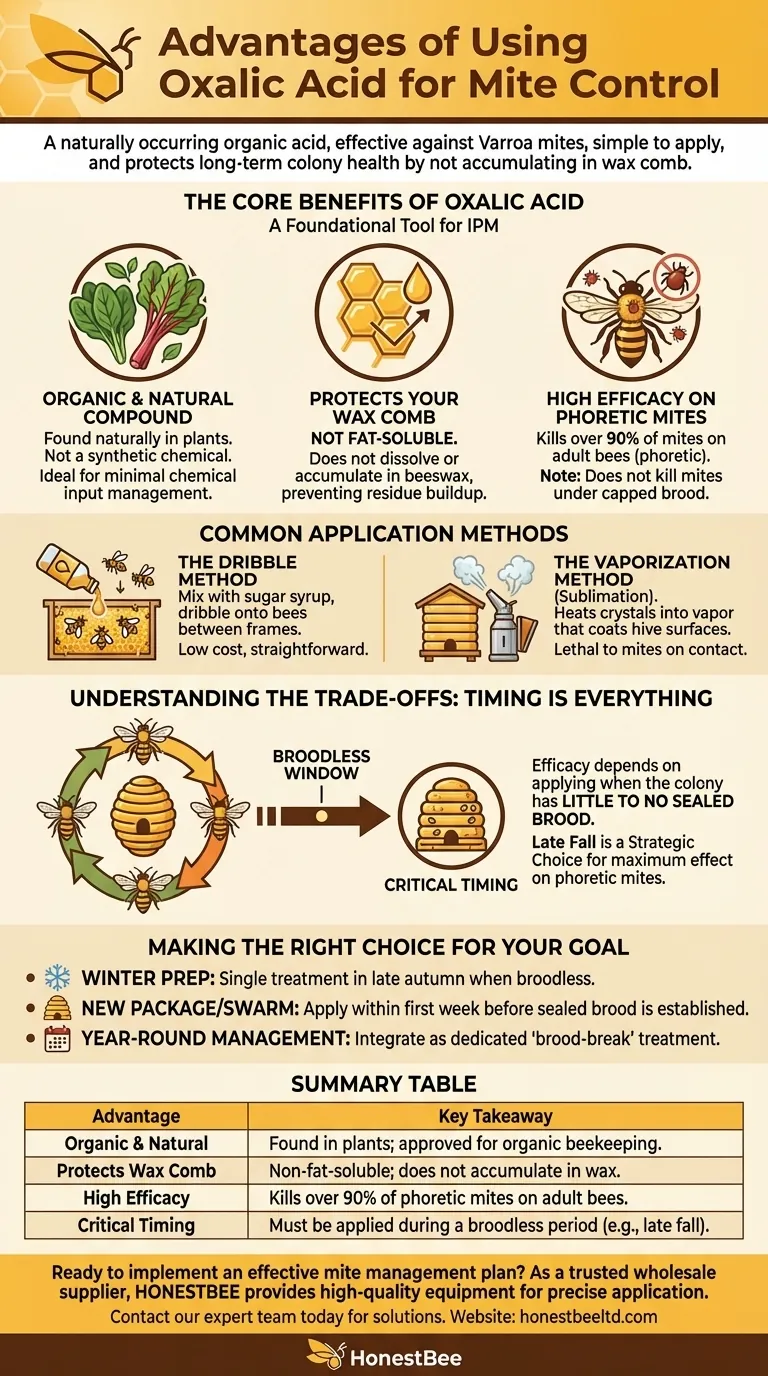
Related Products
- Adjustable Formic and Acetic Acid Dispenser for Bee Mite Treatment
- Professional Bamboo Queen Isolation Cage
- Langstroth Screen Bottom Board for Beekeeping Wholesale
- Black Plastic Beetle Barn Hive Beetle Trap for Beehives
- Professional Galvanized Hive Strap with Secure Locking Buckle for Beekeeping
People Also Ask
- What are the symptoms of Varroa Mite Syndrome (VMS)? Recognizing the Signs of Colony Collapse
- What should be done after treating a colony for varroa mites? A Step-by-Step Guide to Verifying Success
- What are some common predators and pests that target beehives? Protect Your Hives from Bears, Mites, and Beetles
- What are phoretic mites? A Beekeeper's Guide to Monitoring Varroa Infestation
- How do Varroa mites spread between honey bee colonies? Stop Mite Transmission in Your Apiary






